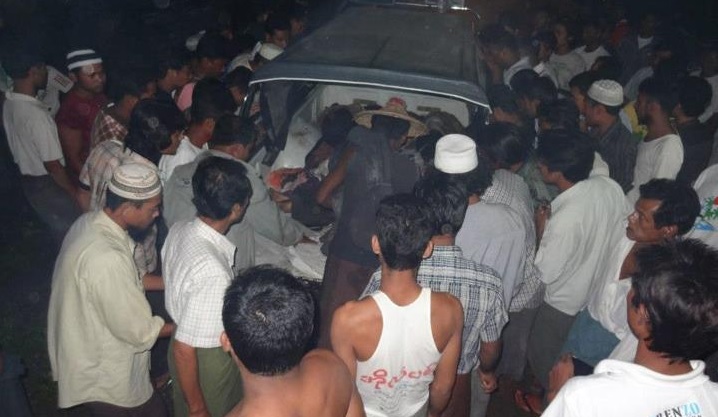Southeast Asian Fronts Loom Closer to Jihad

2014 saw a number of developments further solidifying jihadi attempts to expand their battles to include fronts in Southeast Asia. Jihadi media organizations have continued their efforts to develop content in languages spoken in the region, while al-Qaeda (AQ) even announced the establishment of an official regional wing dedicated to the region.
Crucially, these official jihadi efforts are met by the deepening of local militant capacity, as jihadis looking to establish a local front are increasingly able to back up their ambitions with a cadre of fighters forged in the Syrian conflict. Two proposed battlegrounds in particular—Bangladesh and Burma—deserve a closer look as case studies for how the flood of foreign fighters into Syria may be able to amplify the impact of incitements to create jihadi movements.
Each country reflects a slightly different avenue through which foreign fighters' experiences in Syria may shape the world in 2015. In the case of Bangladesh, fighters are being solicited to obtain training and return to their homelands to carry out jihad. Burma, conversely, may see a related development in an influx of battle-hardened foreign fighters eager to exact revenge against the local Buddhist establishment.
 Both countries have long been identified in jihadi rhetoric as regions for expansion: Bangladesh, as a densely populated Muslim-majority democracy, has been subject to violent social tensions between Islamist and modernist factions. Burma has been on the jihadi radar since reports of Buddhist-led massacres of members of the Rohingya Muslim minority began to circulate in 2012. These events were specifically highlighted as the sites of "two great tragedies in East Asia" by AQ leader Ayman al-Zawahiri in a 2013 video message commemorating the twelfth anniversary of the September 11 attacks. As part of the 72-minute message, he raised the profile of the two lands, stating:
Both countries have long been identified in jihadi rhetoric as regions for expansion: Bangladesh, as a densely populated Muslim-majority democracy, has been subject to violent social tensions between Islamist and modernist factions. Burma has been on the jihadi radar since reports of Buddhist-led massacres of members of the Rohingya Muslim minority began to circulate in 2012. These events were specifically highlighted as the sites of "two great tragedies in East Asia" by AQ leader Ayman al-Zawahiri in a 2013 video message commemorating the twelfth anniversary of the September 11 attacks. As part of the 72-minute message, he raised the profile of the two lands, stating:
Before I conclude, I wish to point out two great tragedies in East Asia. The first tragedy is that of the Muslims in Burma, who are being eaten by the brutality of the Buddhists, and before whose suffering the West is silent...
The second tragedy is that of the Muslims in Bangladesh, where Islam is being clearly fought, and its scholars are killed, imprisoned, and chastised, and thousands of Muslims in the streets are killed, and the atheist government protects those who publicly ridicule the Prophet of Islam
In 2014, AQ took additional steps to foster the development of active jihadi wings in both countries, perhaps underscored by the September 3, 2014 announcement of a new AQ regional branch, "Qaedat al-Jihad in the Indian Subcontinent," also known as "al-Qaeda in the Indian Subcontinent" (AQIS).
While AQIS appears to derive strength from Pakistan...the group expressly identifies their intended scope as throughout the entire region.
While AQIS appears to derive strength from Pakistan (notably, the 55-minute long video release from AQ's media wind, as-Sahab, announcing the formation of AQIS was issued in only Arabic and Urdu), the group expressly identifies their intended scope as throughout the entire region. In a video message released by as-Sahab on September 3, 2014, Zawahiri announced the group as:
...a glad tiding...for the vulnerable in the Indian subcontinent, in Burma, Bangladesh, Assam, Gujurat, Ahmedabad, and Kashmir, [signaling] that your brothers in Qaedat al-Jihad did not forget you and that they are doing what they can to rescue you from injustice, oppression, persecution, and suffering.
A follow-up message from AQIS leader 'Asim Umar, released on September 5, incited Muslims to battle and reiterated the group's intention to expand through Bangladesh, Burma, and India.
Bangladesh
The newly-established AQIS has been strongly appealing to Bangladeshi Muslims, issuing a wide array of Bengali-language jihadi propaganda. One release, in particular, is worth describing in some depth, as it highlights how jihadi groups are looking to build their regional capacity by luring local Muslims to open battlefields to obtain military and ideological training. This approach is being used to encourage Bangladeshi fighters to obtain training from AQIS in Central Asia and, as indicated by social media activity, is also an objective of Bangladeshi fighters in Syria.
 In attempting to encourage a cadre of Bangladeshi fighters to leave their homes and join AQIS camps, a November 29, 2014 video from the group's "Bangla division" explicitly called to Bangladeshi Muslims to come to the jihadi battlefield. Titled "A Glimpse of a Markaz [Center] of Al-Qa'eda in Khurasan," the video keeps with the approach taken by recruiters for other jihadi battlefields, inviting viewers to imagine themselves among the fighters by providing a look at a militant base in the Afghanistan-Pakistan region. As well, the video extolled the experiences of jihad, showcasing testimonies from fighters which celebrated the experiences of engaging in jihad, depicting it as not only the most "profitable" of endeavors, but also a certain path to carry out earthly obligations, such as obligations of dedication and obedience to parents. Indeed, jihad is presented as being akin to a finishing school, with one fighter, identified as "Sulaiman," announcing that he could never have fully-relied his capabilities as a Muslim in Bangladesh, and announcing:
In attempting to encourage a cadre of Bangladeshi fighters to leave their homes and join AQIS camps, a November 29, 2014 video from the group's "Bangla division" explicitly called to Bangladeshi Muslims to come to the jihadi battlefield. Titled "A Glimpse of a Markaz [Center] of Al-Qa'eda in Khurasan," the video keeps with the approach taken by recruiters for other jihadi battlefields, inviting viewers to imagine themselves among the fighters by providing a look at a militant base in the Afghanistan-Pakistan region. As well, the video extolled the experiences of jihad, showcasing testimonies from fighters which celebrated the experiences of engaging in jihad, depicting it as not only the most "profitable" of endeavors, but also a certain path to carry out earthly obligations, such as obligations of dedication and obedience to parents. Indeed, jihad is presented as being akin to a finishing school, with one fighter, identified as "Sulaiman," announcing that he could never have fully-relied his capabilities as a Muslim in Bangladesh, and announcing:
Coming here does not merely imply participating in Jihad or learning to fight; it encompasses every aspect of Islam... developing one's manners, dealings with others. Here, I feel there is the kind of environment that helps one learn how to deal with his family and what one's role should be as a son, a Mujahid, and a Muslim. You can learn everything here so easily.
The encouragement to travel for battlefield training has also been echoed in messages issued by individuals who claim to be Bangladeshi fighters in Syria. Statements shared online indicate that many of these jihadis hope to extend to Bangladesh after finishing the battle in Syria. In an exemplifying Twitter exchange, both Central Asian and Syrian fighters expressed pride in Bangladeshi fighters and agreed:
after finishing all work in Sham & Khurasan Bengali'll return & work in Bangla.

Burma
Burma has been a jihadi cause célèbre since mid-2012 when reports—and, crucially, pictures—began to circulate of Buddhist-lead massacres against the Rohingya Muslim minority.
Just as Syria is becoming a training ground for Bangladeshis who may return home, the influx of foreign fighters into the country may help the jihadi movement establish a solid foothold in Burma. Burma has been a jihadi cause célèbre since mid-2012 when reports—and, crucially, pictures—began to circulate of Buddhist-lead massacres against the Rohingya Muslim minority. In the ensuring years, media releases from Central Asian jihadi groups have featured not only consistent references to the plight of Burmese Muslims, but also high-profile jihadis from the country, such as the Burmese ideologue Abu Dher Azzam, who has been featured in media releases from the central Asian Islamic Movement of Uzbekistan (IMU) and Turkistan Islamic Jihad (TIJ). Among the 2013 incitements for battle, a jihadi military campaign called the "Battle of Burma" included assertions that a multi-national cadre of fighters had arrived in the country, while the Tehrik-i-Taliban Pakistan (TTP) claimed to have sent fighters to the country in August 2013.
However, 2013 reports from the attempts to establish a jihadi front in the country identified a lack of battle-trained fighters and individuals who can instruct new recruits. A message shared on an English-language jihadi forum in June of that year reported on Burmese attempts to obtain support from Indonesian militants, relating that:
...Abu Shafiyah, the commander of the Laskar Mujahideen, focused that the Rohingyan Mujahideen need a bomb instructor, people who are experts to train the Mujahideen to assemble bombs. This is needed for guerrilla attacks against the military junta of Myanmar and other kafir [non-believer] people who are hostile towards the Muslims there
As the flow of south Asian fighters into Syria has continued at a great pace in 2014, local fighters are able to gain more widespread military experience and are better-positioned to carry out regional jihadi ambitions. This flow of fighters from Syria and back may be particularly notable in the case of Indonesian fighters, who have been reported to not only comprise a substantial portion of the militants in Burma, but also a significant cadre of foreign fighters making their way to Syria.